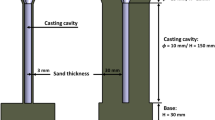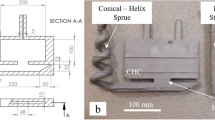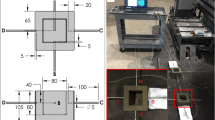Abstract
Three-dimensional sand mold printing is a novel manufacturing method that can produce complicated shapes based on a 3D CAD model. Various types of material systems can be employed to produce 3D-printed sand molds. The thermal and mechanical properties of these sand molds have been extensively studied, but few studies on the effect of the type of 3D-printed sand mold on the shrinkage porosity of the resultant castings have been reported. Shrinkage porosity is a concern that can limit the capability for advanced castings process using 3D-printed sand molds. In this study, aluminum cast alloy A356.0 was cast into typical 3D-printed silica sand molds and an 3D-printed mullite artificial sand mold. The results indicated that differences in cooling capability among these sand molds did not affect the hardness of the A356.0 castings but significantly influenced the location of shrinkage porosities. In particular, sound castings were not obtained from 3D-printed silica sand molds owing to their shrinkage porosity. Thus, a thermal solidification simulation was performed according to the cooling capability of the 3D-printed silica sand mold. The riser shape of the 3D-printed silica sand mold was modified based on the simulation result, and the sound A356.0 casting was made resultantly. This study demonstrated that the use of a riser shape according to the cooling capability of a 3D-printed sand mold is necessary to produce sound castings for the advance casting process using the 3D-printed sand mold.

















Similar content being viewed by others
References
S.R. Sama, T. Badamo, G. Manogharan, Case studies on integrating 3D sand-printing technology into the production portfolio of a sand-casting foundry. Int. J. Metalcast. 14, 12–24 (2020). https://doi.org/10.1007/s40962-019-00340-1
S. Wen, Q. Shen, Q. Wei, C. Yan, W. Zhu, Y. Shi, S. Yang, Y. Shi, Material optimization and post-processing of sand moulds manufactured by the selective laser sintering of binder-coated Al2O3 sands. J. Mater. Process. Technol. 225, 93–102 (2015). https://doi.org/10.1016/j.jmatprotec.2015.05.028
Y. Nagai, K. Takeshita, T. Okane, Additive manufacturing technology by furan sand mold using sintered artificial sand coated with solid catalyst. Mater. Trans. 61(4), 734–739 (2020). https://doi.org/10.2320/matertrans.F-M2020801
P. Rodríguez-González, P.E. Robles Valero, A.I. Fernández-Abia, M.Á. Castro-Sastre, J. Barreiro García, Feasibility of calcium sulfate moulds made by inkjet 3D printing for rapid casting of aluminium alloys. Metals 10(6), 802 (2020). https://doi.org/10.3390/met10060802
S.Y. Chun, G. Lee, S.J. Kim, B. Jeong, J. Shin, I. Cho, D.K. Kim, H. Lee, T. Kim, Effects of post-treatment to improve the surface quality of 3D printing cement mold casting. Appl. Sci. 11(24), 11824 (2021). https://doi.org/10.3390/app112411824
S. Mitra, A.R. de Castro, M. El Mansori, On the rapid manufacturing process of functional 3D printed sand molds. J. Manuf. Process. 42, 202–212 (2019). https://doi.org/10.1016/j.jmapro.2019.04.034
S. Mitra, M.E. Mansori, A.R. de Castro, M. Costin, Study of the evolution of transport properties induced by additive processing sand mold using X-ray computed tomography. J. Mater. Process. Technol. 277, 116495 (2020). https://doi.org/10.1016/j.jmatprotec.2019.116495
T. Sivarupan, M. El Mansori, N. Coniglio, M. Dargusch, Effect of process parameters on flexure strength and gas permeability of 3D printed sand molds. J. Manuf. Process. 54, 420–437 (2020). https://doi.org/10.1016/j.jmapro.2020.02.043
D. Martinez, C. Bate, G. Manogharan, Towards functionally graded sand molds for metal casting: engineering thermo-mechanical properties using 3D sand printing. JOM 72(3), 1340–1354 (2020). https://doi.org/10.1007/s11837-019-03975-x
H.R. Dana, M. El Mansori, Mechanical characterization of anisotropic silica sand/furan resin compound induced by binder jet 3D additive manufacturing technology. Ceram. Int. 46(11), 17867–17880 (2020). https://doi.org/10.1016/j.ceramint.2020.04.093
H. Shangguan, J. Kang, C. Deng, Y. Hu, T. Huang, 3D-printed shell-truss sand mold for aluminum castings. J. Mater. Process. Technol. 250, 247–253 (2017). https://doi.org/10.1016/j.jmatprotec.2017.05.010
J. Kang, H. Shangguan, C. Deng, Y. Hu, J. Yi, X. Wang, X. Zhang, T. Huang, Additive manufacturing-driven mold design for castings. Addit. Manuf. 22, 472–478 (2018). https://doi.org/10.1016/j.addma.2018.04.037
C. Deng, J. Kang, H. Shangguan, Y. Hu, T. Huang, Z. Liu, Effects of hollow structures in sand mold manufactured using 3D printing technology. J. Mater. Process. Technol. 255, 516–523 (2018). https://doi.org/10.1016/j.jmatprotec.2017.12.031
J. Xu, J. Kang, H. Shangguan, C. Deng, Y. Hu, J. Yi, W. Mao, Chimney structure of hollow sand mold for casting solidification. Metals 12(3), 415 (2022). https://doi.org/10.3390/met12030415
S.R. Sama, J. Wang, G. Manogharan, Non-conventional mold design for metal casting using 3D sand-printing. J. Manuf. Process. 34, 765–775 (2018). https://doi.org/10.1016/j.jmapro.2018.03.049
S.R. Sama, T. Badamo, P. Lynch, G. Manogharan, Novel sprue designs in metal casting via 3D sand-printing. Addit. Manuf. 25, 563–578 (2019). https://doi.org/10.1016/j.addma.2018.12.009
J. Walker, E. Harris, C. Lynagh, A. Beck, R. Lonardo, B. Vuksanovich, J. Thiel, K. Rogers, B. Conner, E. MacDonald, 3D printed smart molds for sand casting. Int. J. Metalcast. 12, 785–796 (2018). https://doi.org/10.1007/s40962-018-0211-x
M. Upadhyay, T. Sivarupan, M. El Mansori, 3D printing for rapid sand casting—A review. J. Manuf. Process. 29, 211–220 (2017). https://doi.org/10.1016/j.jmapro.2017.07.017
T. Sivarupan, N. Balasubramani, P. Saxena, D. Nagarajan, M. El Mansori, K. Salonitis, M. Jolly, M.S. Dargusch, A review on the progress and challenges of binder jet 3D printing of sand moulds for advanced casting. Addit. Manuf. 40, 101889 (2021). https://doi.org/10.1016/j.addma.2021.101889
P. Rodríguez-González, A.I. Fernández-Abia, M.A. Castro-Sastre, J. Barreiro, Heat treatments for improved quality binder jetted molds for casting aluminum alloys. Addit. Manuf. 36, 101524 (2020). https://doi.org/10.1016/j.addma.2020.101524
M.Á. Castro-Sastre, C. García-Cabezón, A.I. Fernández-Abia, F. Martín-Pedrosa, J. Barreiro, Comparative study on microstructure and corrosion resistance of Al-Si alloy cast from sand mold and binder jetting mold. Metals 11(9), 1421 (2021). https://doi.org/10.3390/met11091421
I. Goto, K. Kurosawa, T. Matsuki, Effect of 3D-printed sand molds on the soundness of pure copper castings in the vicinity of as-cast surfaces. J. Manuf. Process. 77, 329–338 (2022). https://doi.org/10.1016/j.jmapro.2022.03.020
K.J. Hodder, R.J. Chalaturnyk, Bridging additive manufacturing and sand casting: utilizing foundry sand. Addit. Manuf. 28, 649–660 (2019). https://doi.org/10.1016/j.addma.2019.06.008
D.A. Snelling, C.B. Williams, A.P. Druschitz, Mechanical and material properties of castings produced via 3D printed molds. Addit. Manuf. 27, 199–207 (2019). https://doi.org/10.1016/j.addma.2019.03.004
R.K. Yajjala, N.M. Inampudi, B.R. Jinugu, Correlation between SDAS and mechanical properties of Al–Si alloy made in Sand and Slag moulds. J. Mater. Res. Technol. 9(3), 6257–6267 (2020). https://doi.org/10.1016/j.jmrt.2020.02.066
Y. Awano, K. Morimoto, Shrinkage morphology of Al–Si casting alloys. Int. J. Cast Met. Res. 17(2), 107–114 (2004). https://doi.org/10.1179/136404604225014846
M. Saeidpour, R. Svenningsson, U. Gotthardsson, S. Farre, Thermal properties of 3D-printed sand molds. Int. J. Metalcast. 16(1), 252–258 (2022). https://doi.org/10.1007/s40962-021-00583-x
Acknowledgements
The authors would like to acknowledge Gun Ei Chemical Industry Co., Ltd. for providing 3D printed sand mold materials. They also thank Dr. Tetsuyoshi Suzuki (AIST) and Mr. Mikio Ebata (AIST) are for their assistance.
Funding
This study was conducted using research funds provided by CMET Co.,Ltd.
Author information
Authors and Affiliations
Corresponding author
Ethics declarations
Conflict of interest
The authors have not disclosed any conflict of interest.
Additional information
Publisher's Note
Springer Nature remains neutral with regard to jurisdictional claims in published maps and institutional affiliations.
Appendix 1
Appendix 1
Boundary conditions and thermal properties used in the casting solidification simulation
The heat transfer equations in the casting solidification simulation were solved using finite difference method software. The casting temperature \(T\) as a function of time \(t\) was calculated using the following equation.
where, \(\lambda\), \(C_{p}\), \(\rho\), \(f_{s}\), \(H\), and \(L\) are the thermal conductivity, specific heat, density, solid fraction, enthalpy, and latent heat, respectively. The heat flow \({\text{q}}\) at the boundaries was solved using the following equations.
where \(h\), \(T_{sur, cast}\), \(T_{sur, mold}\), \(T_{air}\), \(T_{int, cast}\), and \(T_{int,mold}\) are the heat transfer coefficient (HTC), casting surface temperature, mold surface temperature, air temperature, casting temperature at the interface, and mold temperature at the interface, respectively. Table
3, Figures
18,
19, and
20 show the parameters inputted in the casting solidification simulation.
Rights and permissions
Springer Nature or its licensor (e.g. a society or other partner) holds exclusive rights to this article under a publishing agreement with the author(s) or other rightsholder(s); author self-archiving of the accepted manuscript version of this article is solely governed by the terms of such publishing agreement and applicable law.
About this article
Cite this article
Motoyama, Y., Tokunaga, H., Hashiguchi, M. et al. Effect of the Cooling Capability Difference Between Additively Manufactured Sand Molds on Shrinkage Defect in A356 Alloy Castings. Inter Metalcast 18, 1424–1437 (2024). https://doi.org/10.1007/s40962-023-01120-8
Received:
Accepted:
Published:
Issue Date:
DOI: https://doi.org/10.1007/s40962-023-01120-8







